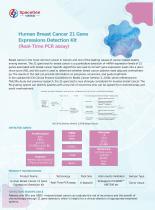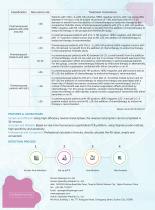
Catalog excerpts

Human Breast Cancer 21 Gene Expressions Detection Kit (Real-Time PCR assay) Breast cancer is the most common cancer in women and one of the leading causes of cancer-related deaths among women. The 21-gene test for breast cancer is a quantitative detection of mRNA expression levels of 21 genes associated with breast cancer. Specific algorithms are used to convert gene expression levels into a recurrence score (RS), and the score is used to determine whether breast cancer patients need adjuvant chemotherapy. The results of this test can provide information on prognosis, recurrence, and guide treatment. In the updated NCCN Clinical Practice Guidelines for Breast Cancer (Version 3, 2018), which references the TAILORx study and previous research, the 21-gene test is now strongly considered for invasive breast cancer. The RS grading system can identify patients with a low risk of recurrence who can be spared from chemotherapy and avoid overtreatment. NCCN Guidelines Version 3.2018 Breast Cancer DETECTED GENES Estrogen ER PGR BCL2 SCUBE2 Reference ACTB ( β-actin) GAPDH RPLPO Gus TFRC PRODUCT INFORMATION Product Name Pack Size Instruments Validated Sample Type Human Breast Cancer 21 Gene Expressions Detection Kit Tumor tissue DETECTION SIGNIFICANCE Patients with ER+ and HER2- invasive breast cancer can evaluate the risk of recurrence and the benefit of chemotherapy through 21 gene detection, which is helpful for a clinical selection of appropriate treatment option
Open the catalog to page 1
Recurrence risk Treatment Implications In postmenopausal patients with pT1–3, HR-positive, HER2-negative, and pN0 and pN1 (1–3 positive nodes) tumors and an RS ≥26, the addition of chemotherapy to endocrine therapy is recommended. Premenopausal patients with T1b/c –2, pN0, HR-positive, HER2-negative tumors with RS <16 derived no benefit from the addition of chemotherapy to endocrine therapy in the prospective TAILORx study. Postmenopausal patients with pN0 and pN1 Patients with T1b/c–2, pN0, HR-positive, HER2-negative tumors, with risk scores (RS) between 0–10 have a risk of distant...
Open the catalog to page 2






























